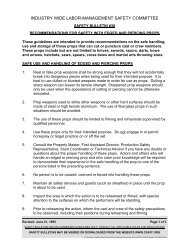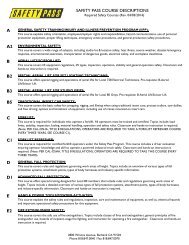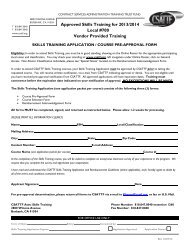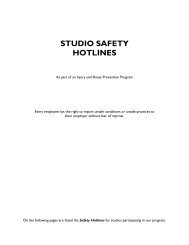General Code of Safe Practices for Production - csatf
General Code of Safe Practices for Production - csatf
General Code of Safe Practices for Production - csatf
Create successful ePaper yourself
Turn your PDF publications into a flip-book with our unique Google optimized e-Paper software.
<strong>General</strong> <strong>Code</strong> <strong>of</strong> <strong>Safe</strong> <strong>Practices</strong><br />
Know as much as you can about the<br />
body <strong>of</strong> water you’re working on or in,<br />
including its natural hazards and animal<br />
life. The <strong>Production</strong> Company, Location<br />
Manager or the <strong>Safe</strong>ty Coordinator<br />
should have all relevant in<strong>for</strong>mation.<br />
If personnel are going to enter the water,<br />
when appropriate, samples <strong>of</strong> the water<br />
should be taken and analyzed <strong>for</strong> any<br />
potential environmental concerns and/or<br />
health hazards.<br />
Additional in<strong>for</strong>mation can be found<br />
in Industry <strong>Safe</strong>ty Bulletins #7, #15<br />
and #17.<br />
by the special effects and/or stunt<br />
coordinator shall be allowed in the area.<br />
Radios, cell phones, pagers, personal<br />
data assistants (PDAs), transmitting<br />
equipment or remote control equipment<br />
should not be used around pyrotechnic<br />
or other explosive devices.<br />
Additional in<strong>for</strong>mation can be found<br />
in Industry <strong>Safe</strong>ty Bulletins #1, #2,<br />
#3A, #4, #11A, #14, #16, #18, #20,<br />
#29A, #30 and #37.<br />
10. ARTIFICIALLY CREATED SMOKES,<br />
FOGS & DUST EFFECTS<br />
9. STUNTS & SPECIAL EFFECTS<br />
All stunts and special effects should be<br />
reviewed by all participants prior to<br />
execution to help ensure that they are<br />
per<strong>for</strong>med in the safest manner possible.<br />
Be<strong>for</strong>e filming a stunt or special effect,<br />
the involved parties should all per<strong>for</strong>m an<br />
on-site dry run or walk-through. A safety<br />
meeting should be held and<br />
documented.<br />
Special effects involving pyrotechnics,<br />
explosives and/or fire must be noted in<br />
advance on the call sheet. Properly<br />
licensed individuals must per<strong>for</strong>m all<br />
such effects. The necessary permits<br />
must be obtained and the appropriate<br />
regulatory agencies notified. Explosives<br />
must be stored and disposed <strong>of</strong> properly.<br />
Appropriate personal protection<br />
equipment (PPE) and/or other safety<br />
equipment must be provided to the cast<br />
and crew as needed. There must be a<br />
planned escape route and each person<br />
involved should personally check all<br />
escape routes. Only persons authorized<br />
Be aware that the use <strong>of</strong> atmosphere<br />
smoke has become highly regulated and<br />
limited by a variety <strong>of</strong> regulatory<br />
agencies. Contact the <strong>Safe</strong>ty<br />
Coordinator or Studio <strong>Safe</strong>ty<br />
Representative <strong>for</strong> guidelines and<br />
regulations.<br />
Additional in<strong>for</strong>mation can be found<br />
in Industry <strong>Safe</strong>ty Bulletin #10 and the<br />
Photographic Dust Awareness Sheet.<br />
11. FIREARMS & OTHER WEAPONS<br />
Treat all weapons as though they are<br />
loaded and/or ready to use. Do not play<br />
with weapons and never point one at<br />
anyone, including yourself. Follow the<br />
directions <strong>of</strong> the Property Master and/or<br />
Weapons Handler regarding all weapons.<br />
The use <strong>of</strong> firearms and other weapons<br />
may require special permits and/or operator<br />
certifications. Anyone that will be using a<br />
weapon shall know all the operating<br />
features and safety devices. All weapons<br />
must undergo thorough safety inspection,<br />
testing and cleaning on a daily basis by<br />
qualified personnel.<br />
Revised: October 17, 2002 Page 6 <strong>of</strong> 7<br />
THIS CODE OF SAFE PRACTICES IS A RECOMMENDED GUIDELINE ONLY; CONSULT ALL APPLICABLE RULES AND REGULATIONS<br />
SAFETY BULLETINS MAY BE VIEWED OR DOWNLOADED FROM THE WEBSITE WWW.CSATF.ORG<br />
G:\wpdata\AMPTP\Bulletins\Current\Gen <strong>Code</strong> <strong>of</strong> <strong>Safe</strong> <strong>Practices</strong>.doc






